Spatial distribution models¶
This page shows how you can use the Random Forest algorithm to make spatial predictions. This approach is widely used, for example to classify remote sensing data into different land cover classes. But here our objective is to predict the entire range of a species based on a set of locations where it has been observed. As an example, we use the hominid species Imaginus magnapedum (also known under the vernacular names of “bigfoot” and “sasquatch”). This species is so hard to find (at least by scientists) that its very existence is commonly denied by the mainstream media! For more information about this controversy, see the article by Lozier, Aniello and Hickerson: Predicting the distribution of Sasquatch in western North America: anything goes with ecological niche modelling.
We want to find out
What the complete range of the species might be.
How good (general) our model is by predicting the range of the Eastern sub-species, with data from the Western sub-species.
Predict where in Mexico the creature is likely to occur.
How climate change might affect its distribution.
In this context, this type of analysis is often referred to as ‘species distribution modeling’ or ‘ecological niche modeling’. Here is a more in-depth discussion of this technique.
Data¶
Observations¶
if (!require("rspatial")) remotes::install_github('rspatial/rspatial')
library(rspatial)
bf <- sp_data('bigfoot')
dim(bf)
## [1] 3092 3
head(bf)
## lon lat Class
## 1 -142.9000 61.50000 A
## 2 -132.7982 55.18720 A
## 3 -132.8202 55.20350 A
## 4 -141.5667 62.93750 A
## 5 -149.7853 61.05950 A
## 6 -141.3165 62.77335 A
Plot the locations
plot(bf[,1:2], cex=0.5, col='red')
library(maptools)
## Checking rgeos availability: TRUE
## Please note that 'maptools' will be retired by the end of 2023,
## plan transition at your earliest convenience;
## some functionality will be moved to 'sp'.
data(wrld_simpl)
plot(wrld_simpl, add=TRUE)
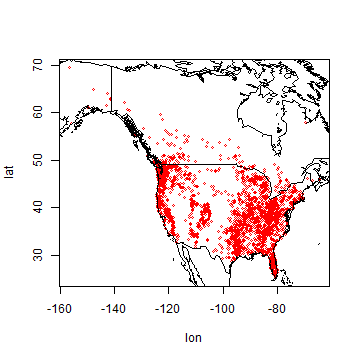
Predictors¶
Supervised classification often uses predictor data obtained from satellite remote sensing. But here, as is common in species distribution modeling, we use climate data. Specifically, we use ‘bioclimatic variables’, see: http://www.worldclim.org/bioclim
library(raster)
wc <- raster::getData('worldclim', res=10, var='bio')
plot(wc[[c(1, 12)]], nr=2)
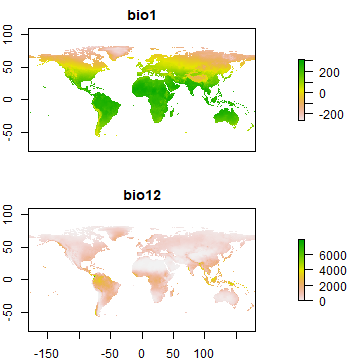
Now extract climate data for the locations of our observations. That is, get data about the climate that the species likes, apparently.
bfc <- extract(wc, bf[,1:2])
head(bfc)
## bio1 bio2 bio3 bio4 bio5 bio6 bio7 bio8 bio9 bio10 bio11 bio12 bio13
## [1,] -14 102 27 9672 174 -197 371 51 -11 108 -137 973 119
## [2,] 62 55 31 4136 157 -17 174 43 98 118 15 2602 385
## [3,] 62 55 31 4136 157 -17 174 43 98 118 15 2602 385
## [4,] -57 125 23 15138 206 -332 538 127 -129 127 -256 282 67
## [5,] 10 80 25 8308 174 -140 314 66 5 119 -91 532 81
## [6,] -59 128 23 14923 204 -334 538 122 -130 122 -255 322 75
## bio14 bio15 bio16 bio17 bio18 bio19
## [1,] 43 30 332 156 290 210
## [2,] 128 33 953 407 556 721
## [3,] 128 33 953 407 556 721
## [4,] 6 81 163 22 163 27
## [5,] 22 41 215 72 159 117
## [6,] 8 79 183 28 183 32
# Any missing values?
i <- which(is.na(bfc[,1]))
i
## [1] 862 2667
plot(bf[,1:2], cex=0.5, col='blue')
plot(wrld_simpl, add=TRUE)
points(bf[i, ], pch=20, cex=3, col='red')
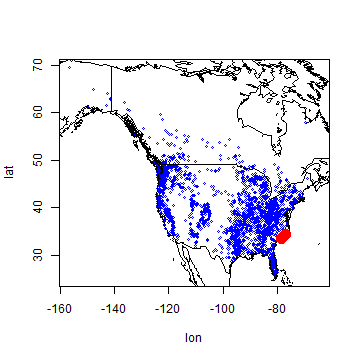
Here is a plot that illustrates a component of the ecological niche of our species of interest.
plot(bfc[ ,'bio1'] / 10, bfc[, 'bio12'], xlab='Annual mean temperature (C)',
ylab='Annual precipitation (mm)')

Background data¶
Normally, one would build a model that would compare the values of the predictor variables as the locations where something was observed, with those values at the locations where it was not observed. But we do not have data from a systematic survey that determined presence and absence. We have presence-only data. (And, determining absence is not that simple. It is here now, it is gone tomorrow).
The common trick to deal with this is to not model presence versus absence, but presence versus a ‘random expectation’. This random expectation (also referred to as ‘background’, or ‘random-absence’ data) is what you would get if the species had no preference for any of the predictor variables (or to other variables that are not in the model, but correlated with the predictor variables).
There is not much point in taking absence data from very far away (tropical Africa or Antarctica). Typically they are taken from more or less the entire study area for which we have presences data.
library(dismo)
# extent of all points
e <- extent(SpatialPoints(bf[, 1:2]))
e
## class : Extent
## xmin : -156.75
## xmax : -64.4627
## ymin : 25.141
## ymax : 69.5
# 5000 random samples (excluding NA cells) from extent e
set.seed(0)
bg <- sampleRandom(wc, 5000, ext=e)
dim(bg)
## [1] 5000 19
head(bg)
## bio1 bio2 bio3 bio4 bio5 bio6 bio7 bio8 bio9 bio10 bio11 bio12 bio13
## [1,] 157 126 60 2935 262 55 207 124 191 197 122 379 88
## [2,] -54 105 28 9244 142 -223 365 57 -62 68 -165 639 79
## [3,] -57 104 20 14227 198 -317 515 106 -227 118 -247 473 71
## [4,] 1 119 24 12335 231 -251 482 138 -91 150 -168 844 104
## [5,] 208 169 44 7641 404 28 376 304 239 307 114 198 31
## [6,] -89 111 23 12931 160 -316 476 78 -174 78 -248 476 76
## bio14 bio15 bio16 bio17 bio18 bio19
## [1,] 0 100 225 2 4 222
## [2,] 28 30 226 101 219 138
## [3,] 17 46 197 55 194 59
## [4,] 34 33 301 128 291 137
## [5,] 2 50 73 11 52 62
## [6,] 25 40 193 79 193 82
Combine presence and background¶
d <- rbind(cbind(pa=1, bfc), cbind(pa=0, bg))
d <- data.frame(d)
dim(d)
## [1] 8092 20
Fit a model¶
Now we have the data to fit a model. But I am going to split the data into East and West. Let’s say I believe these are actually are different, albeit related, sub-species (The Eastern Sasquatch is darker and less hairy). I am principally interested in the western sub-species.
de <- d[bf[,1] > -102, ]
dw <- d[bf[,1] <= -102, ]
CART¶
Let’s first look at a Classification and Regression Trees (CART) model.
library(rpart)
cart <- rpart(pa~., data=dw)
printcp(cart)
##
## Regression tree:
## rpart(formula = pa ~ ., data = dw)
##
## Variables actually used in tree construction:
## [1] bio10 bio14 bio15 bio18 bio3 bio4 bio5 bio6 bio8
##
## Root node error: 762.45/3246 = 0.23489
##
## n= 3246
##
## CP nsplit rel error xerror xstd
## 1 0.410197 0 1.00000 1.00071 0.008912
## 2 0.137588 1 0.58980 0.59037 0.014184
## 3 0.044259 2 0.45222 0.45958 0.016681
## 4 0.029121 3 0.40796 0.43353 0.016756
## 5 0.018954 4 0.37884 0.40941 0.016615
## 6 0.018324 5 0.35988 0.39714 0.016313
## 7 0.010113 6 0.34156 0.37834 0.015761
## 8 0.010008 7 0.33144 0.36700 0.016047
## 9 0.010000 9 0.31143 0.36700 0.016047
plotcp(cart)
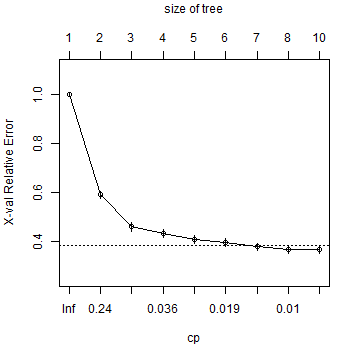
And here is the tree
plot(cart, uniform=TRUE, main="Regression Tree")
# text(cart, use.n=TRUE, all=TRUE, cex=.8)
text(cart, cex=.8, digits=1)
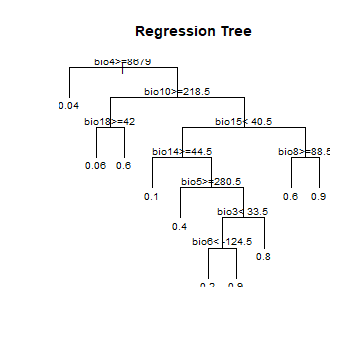
Question 1: Describe the conditions under which you have the highest probability of finding our beloved species?
Random Forest¶
CART gives us a nice result to look at that can be easily interpreted (as you just illustrated with your answer to Question 1). But the approach suffers from high variance (meaning that the model will be over-fit, it is different each time a somewhat different datasets are used). Random Forest does not have that problem as much. Above, with CART, we use regression, let’s do both regression and classification here. First classification.
library(randomForest)
## randomForest 4.6-14
## Type rfNews() to see new features/changes/bug fixes.
# create a factor to indicated that we want classification
fpa <- as.factor(dw[, 'pa'])
Now fit the RandomForest model
crf <- randomForest(dw[, 2:ncol(dw)], fpa)
crf
##
## Call:
## randomForest(x = dw[, 2:ncol(dw)], y = fpa)
## Type of random forest: classification
## Number of trees: 500
## No. of variables tried at each split: 4
##
## OOB estimate of error rate: 9.92%
## Confusion matrix:
## 0 1 class.error
## 0 1862 160 0.07912957
## 1 162 1062 0.13235294
plot(crf)
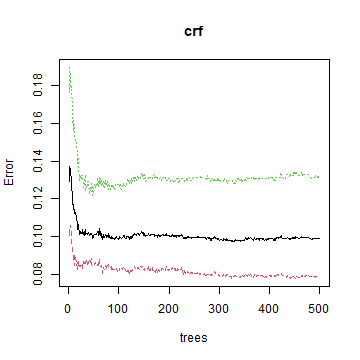
The variable importance plot shows which variables are most important in fitting the model. This is computing by randomizing each variable one by one and then computing the decline in model prediction.
varImpPlot(crf)
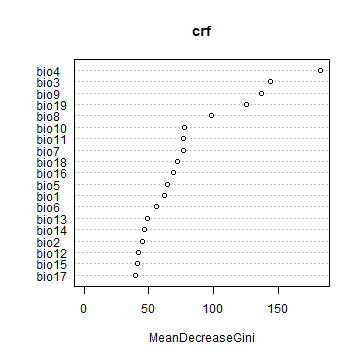
Now we use regression, rather than classification. First we tune a parameter.
trf <- tuneRF(dw[, 2:ncol(dw)], dw[, 'pa'])
## Warning in randomForest.default(x, y, mtry = mtryStart, ntree = ntreeTry, :
## The response has five or fewer unique values. Are you sure you want to do
## regression?
## mtry = 6 OOB error = 0.07223543
## Searching left ...
## Warning in randomForest.default(x, y, mtry = mtryCur, ntree = ntreeTry, :
## The response has five or fewer unique values. Are you sure you want to do
## regression?
## mtry = 3 OOB error = 0.07002109
## 0.03065438 0.05
## Searching right ...
## Warning in randomForest.default(x, y, mtry = mtryCur, ntree = ntreeTry, :
## The response has five or fewer unique values. Are you sure you want to do
## regression?
## mtry = 12 OOB error = 0.07146042
## 0.01072891 0.05
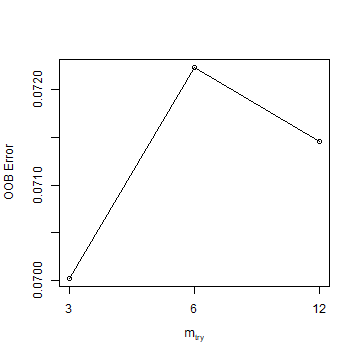
trf
## mtry OOBError
## 3 3 0.07002109
## 6 6 0.07223543
## 12 12 0.07146042
mt <- trf[which.min(trf[,2]), 1]
mt
## [1] 3
Question 2: What did tuneRF help us find? What does the values of mt represent?
rrf <- randomForest(dw[, 2:ncol(d)], dw[, 'pa'], mtry=mt)
## Warning in randomForest.default(dw[, 2:ncol(d)], dw[, "pa"], mtry = mt):
## The response has five or fewer unique values. Are you sure you want to do
## regression?
rrf
##
## Call:
## randomForest(x = dw[, 2:ncol(d)], y = dw[, "pa"], mtry = mt)
## Type of random forest: regression
## Number of trees: 500
## No. of variables tried at each split: 3
##
## Mean of squared residuals: 0.06842395
## % Var explained: 70.87
plot(rrf)
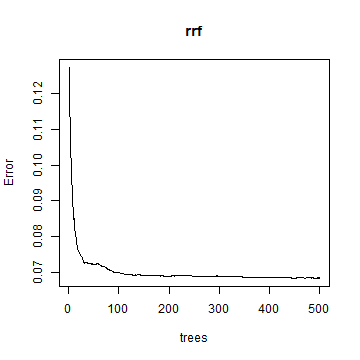
varImpPlot(rrf)
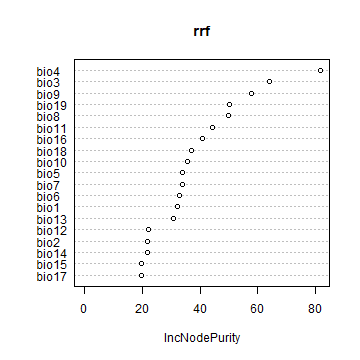
Predict¶
We can use the model to make predictions to any other place for which we have values for the predictor variables. Our climate data is global so we could find suitable places for bigfoot in Australia. At first I only want to predict to our study region, which I define as follows.
# Extent of the western points
ew <- extent(SpatialPoints(bf[bf[,1] <= -102, 1:2]))
ew
## class : Extent
## xmin : -156.75
## xmax : -102.3881
## ymin : 30.77722
## ymax : 69.5
Regression¶
rp <- predict(wc, rrf, ext=ew)
plot(rp)
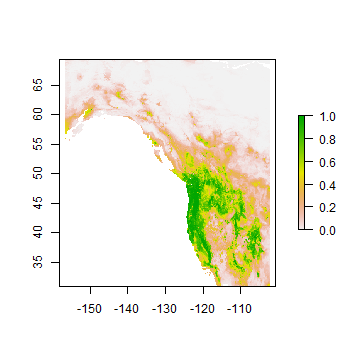
Note that the regression predictions are well-behaved, in the sense that they are between 0 and 1. However, they are continuous within that range, and if you wanted presence/absence, you would need a threshold. To get the optimal threshold, you would normally have a hold out data set, but here I used the training data for simplicity.
eva <- evaluate(dw[dw$pa==1, ], dw[dw$pa==0, ], rrf)
eva
## class : ModelEvaluation
## n presences : 1224
## n absences : 2022
## AUC : 0.9993911
## cor : 0.964508
## max TPR+TNR at : 0.4982011
We can make a ROC plot
plot(eva, 'ROC')

Find a good threshold to determine presence/absence and plot the prediction.
tr <- threshold(eva)
tr
## kappa spec_sens no_omission prevalence equal_sens_spec
## thresholds 0.4982011 0.4982011 0.3976191 0.3785858 0.5176767
## sensitivity
## thresholds 0.7221367
plot(rp > tr[1, 'spec_sens'])
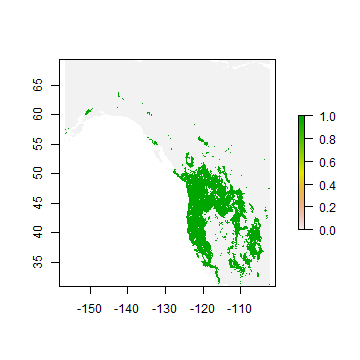
Classification¶
We can also use the classification Random Forest model to make a prediction.
rc <- predict(wc, crf, ext=ew)
plot(rc)
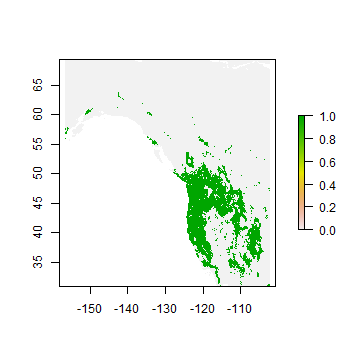
You can also get probabilities for the classes
rc2 <- predict(wc, crf, ext=ew, type='prob', index=2)
plot(rc2)

Extrapolation¶
Now, let’s see if our model is general enough to predict the distribution of the Eastern species.
de <- na.omit(de)
eva2 <- evaluate(de[de$pa==1, ], de[de$pa==0, ], rrf)
eva2
## class : ModelEvaluation
## n presences : 1866
## n absences : 2978
## AUC : 0.4271887
## cor : -0.260545
## max TPR+TNR at : 3e-04
plot(eva2, 'ROC')
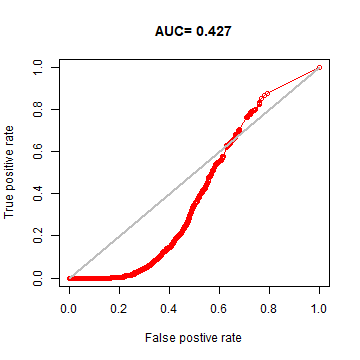
We can also look at it on a map.
eus <- extent(SpatialPoints(bf[, 1:2]))
eus
## class : Extent
## xmin : -156.75
## xmax : -64.4627
## ymin : 25.141
## ymax : 69.5
rcusa <- predict(wc, rrf, ext=eus)
plot(rcusa)
points(bf[,1:2], cex=.25)
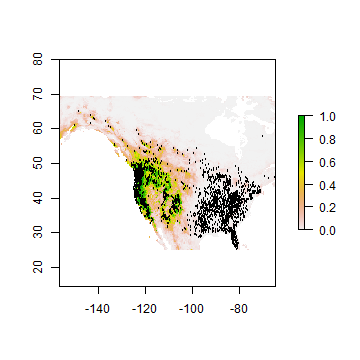
Question 3: Why would it be that the model does not extrapolate well?
An important question in the biogeography of the western species is why it does not occur in Mexico. Or if it does, where would that be?
Let’s see.
mex <- getData('GADM', country='MEX', level=1)
pm <- predict(wc, rrf, ext=mex)
pm <- mask(pm, mex)
plot(pm)
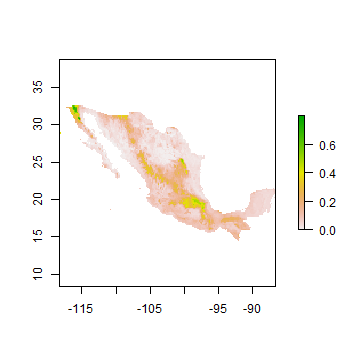
Question 4: Where in Mexico are you most likely to encounter western bigfoot?
We can also estimate range shifts due to climate change
fut <- getData('CMIP5', res=10, var='bio', rcp=85, model='AC', year=70)
names(fut)
## [1] "ac85bi701" "ac85bi702" "ac85bi703" "ac85bi704" "ac85bi705"
## [6] "ac85bi706" "ac85bi707" "ac85bi708" "ac85bi709" "ac85bi7010"
## [11] "ac85bi7011" "ac85bi7012" "ac85bi7013" "ac85bi7014" "ac85bi7015"
## [16] "ac85bi7016" "ac85bi7017" "ac85bi7018" "ac85bi7019"
names(wc)
## [1] "bio1" "bio2" "bio3" "bio4" "bio5" "bio6" "bio7" "bio8" "bio9"
## [10] "bio10" "bio11" "bio12" "bio13" "bio14" "bio15" "bio16" "bio17" "bio18"
## [19] "bio19"
names(fut) <- names(wc)
futusa <- predict(fut, rrf, ext=eus, progress='window')
## Loading required namespace: tcltk
plot(futusa)
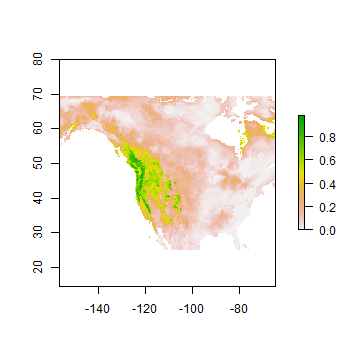
Question 5: Make a map to show where conditions are improving for western bigfoot, and where they are not. Is the species headed toward extinction?
Further reading¶
More on Species distribution modeling with R; and on the use of boosted regression trees in the same context.